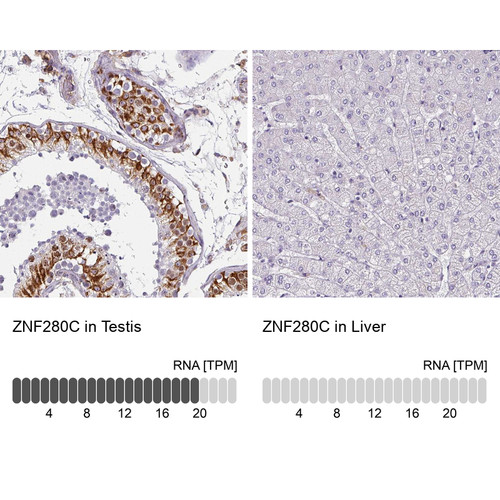Anti ZNF280C pAb (ATL-HPA051494 w/enhanced validation)
Atlas Antibodies
- SKU:
- ATL-HPA051494-100
- Shipping:
- Calculated at Checkout
$596.00
Gene Name: ZNF280C
Alternative Gene Name: FLJ20095, SUHW3, ZNF633
Isotype: IgG
Interspecies mouse/rat: ENSMUSG00000036916: 50%, ENSRNOG00000006797: 47%
Entrez Gene ID: 55609
Uniprot ID: Q8ND82
Buffer: 40% glycerol and PBS (pH 7.2). 0.02% sodium azide is added as preservative.
Storage Temperature: Store at +4°C for short term storage. Long time storage is recommended at -20°C.
| Product Specifications | |
| Application | WB, ICC, IHC |
| Reactivity | Human |
| Clonality | Polyclonal |
| Host | Rabbit |
| Immunogen | VSKSSQSSVTVENASKPDFTKNSQVGSDNSSILLFDSTQESLPPSQDIPAIFREGMKNTSYVLKHPSTSKVNSVTPKKPKTSEDV |
| Gene Sequence | VSKSSQSSVTVENASKPDFTKNSQVGSDNSSILLFDSTQESLPPSQDIPAIFREGMKNTSYVLKHPSTSKVNSVTPKKPKTSEDV |
| Gene ID - Mouse | ENSMUSG00000036916 |
| Gene ID - Rat | ENSRNOG00000006797 |
| Buffer | 40% glycerol and PBS (pH 7.2). 0.02% sodium azide is added as preservative. |
| Documents & Links for Anti ZNF280C pAb (ATL-HPA051494 w/enhanced validation) | |
| Datasheet | Anti ZNF280C pAb (ATL-HPA051494 w/enhanced validation) Datasheet (External Link) |
| Vendor Page | Anti ZNF280C pAb (ATL-HPA051494 w/enhanced validation) at Atlas Antibodies |
| Documents & Links for Anti ZNF280C pAb (ATL-HPA051494 w/enhanced validation) | |
| Datasheet | Anti ZNF280C pAb (ATL-HPA051494 w/enhanced validation) Datasheet (External Link) |
| Vendor Page | Anti ZNF280C pAb (ATL-HPA051494 w/enhanced validation) |
| Citations for Anti ZNF280C pAb (ATL-HPA051494 w/enhanced validation) – 1 Found |
| Sawada, Junko; Hiraoka, Nobuyoshi; Qi, Rongsu; Jiang, Lu; Fournier-Goss, Ashley E; Yoshida, Masayuki; Kawashima, Hiroto; Komatsu, Masanobu. Molecular Signature of Tumor-Associated High Endothelial Venules That Can Predict Breast Cancer Survival. Cancer Immunology Research. 2022;10(4):468-481. PubMed |



![Lane 1: Marker [kDa] 250, 130, 95, 72, 55, 36, 28, 17, 10<br/>Lane 2: Human cell line RT-4<br/>Lane 3: Human cell line U-251MG sp Lane 1: Marker [kDa] 250, 130, 95, 72, 55, 36, 28, 17, 10<br/>Lane 2: Human cell line RT-4<br/>Lane 3: Human cell line U-251MG sp](https://cdn11.bigcommerce.com/s-ydswqc5qsc/images/stencil/500x659/products/95453/173325/atl-hpa051494_anti-znf280c-pab-atl-hpa051494-wenhanced-validation_54980__44451.1681127573.jpg?c=2)